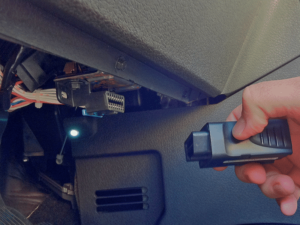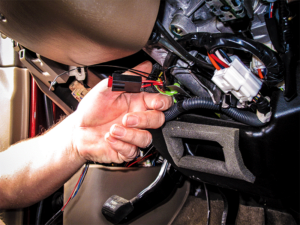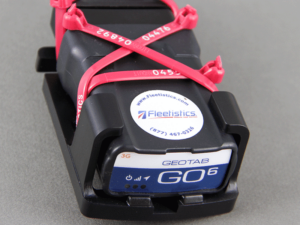GPS installation Tips
At Fleetistics, we understand the pivotal role that precise GPS installation plays in optimizing fleet management. Our cutting-edge fleet management software empowers you with real-time insights, making every journey a well-planned and efficient one. To ensure you harness the full potential of our technology, we’ve compiled these comprehensive GPS installation tips for a seamless experience.
GPS Installation Concepts
With the introduction of OBD GPS trackers many customers opt to do their own installations to save time and money. An OBD device can be installed in 20 minutes in most vehicles once a few have been completed. If in doubt, contact a professional installation company.
If wiring the GPS device is needed, it is better to hire a professional who is familiar with proper connection points to avoid damaging a vehicle.

OBD GPS Vehicle Tracker

Most fleet managers are opting to install an OBD tracker with a Y-harness. This leaves the OBD port available for future maintenance without removing the GPS tracker. The GPS tracker can then be secured in the dash to avoid accidental removal.
Securing the device to the vehicle is important to receive quality accelerometer data. If the GPS device moves independently of vehicles frame, you will get a lot of false positives. In extreme cases the GPS manufacturer will deactivate the accelerometer due to excessive network traffic.
GPS Fleet Tracking 3-Wire Install

Modern vehicles have a lot of expensive computers. Connecting to the wrong wire could result in damage or a safety issue not covered by the manufacturer warranty. Outsourcing the installation generally means the work can be done at night or on weekends to avoid impacting operations.
Install Tips Part 1
- Always follow the manufacturers’ instructions. These instructions do not supersede the manufacturers’ instructions.
- Inventory all parts on receipt. Check for damage or missing components.
- Always use a 3 to 5-amp in-line fuse to protect the unit from damage and prevent damage not covered by warranty.
- Install real-time units as quickly as possible. Real-time service billing starts within 14-days of the units being delivered.
- Use Torque Seal on connections or a serial number zip tie to identify tampering issues. OBD devices do not require this step.
- Connect wires using the poke and wrap connection method or double bladded Scotch Locks. Do not use T-taps or single blade Scotch Locks; they work loose over time.
- Always use a multi-meter to find your connection wires.
- Make sure wires are not pinched or repeatedly closed in doors.
Install Tips Part 2
- Install GPS unit behind the radio, in the OBD or J-Bus port or near the steering column.
- For 3-wire installs, make sure GPS unit gets constant 12v power even when the ignition is off by testing with a multi-meter. Watch the power when the vehicle is started and shut down. Some power leads can lose all power during starting which will cause problems with the GPS systems. It should not dip below 9 volts.
- For 3-wire installs, make sure you have a good ground secured with a screw and Torque Seal.
- For 3-wire installs, if using switched power test, test the power as the ignition is turned on and off.
- Do not block or cover the GPS antenna with metal.
- For 3-wire installs, the optimum location for the cellular and GPS antenna is on the windshield of the vehicle.
- Antennas are directional; make sure it is facing up and lying as flat as possible. Secure them in place with 3M automotive tape or zip ties or a mounting bracket so the device moves with the vehicles frame.
- For 3-wire installs, secure antennas placed inside the dash so they don’t shift at a later time and create a communication issue.
- Make sure the GPS system is operating correctly before closing up the dash. Check lights, tones, on-line display or sample data depending on system. This may require driving the vehicle for 3-5 miles in poor cellular coverage areas.
- For 3-wire installs, never tap into wires that may impact the safety of the vehicle such as an airbag wire. Steering columns is generally the best option.
GPS Tracker Mounting Bracket

View more GPS Installation Tips
Your Guide to Seamless GPS Installation
Choose the Right Location
Power Source Considerations
Securing the GPS Device
Integration with Fleetistics Software
Contact us today to learn more about GPS Installation and how it can benefit your business.
